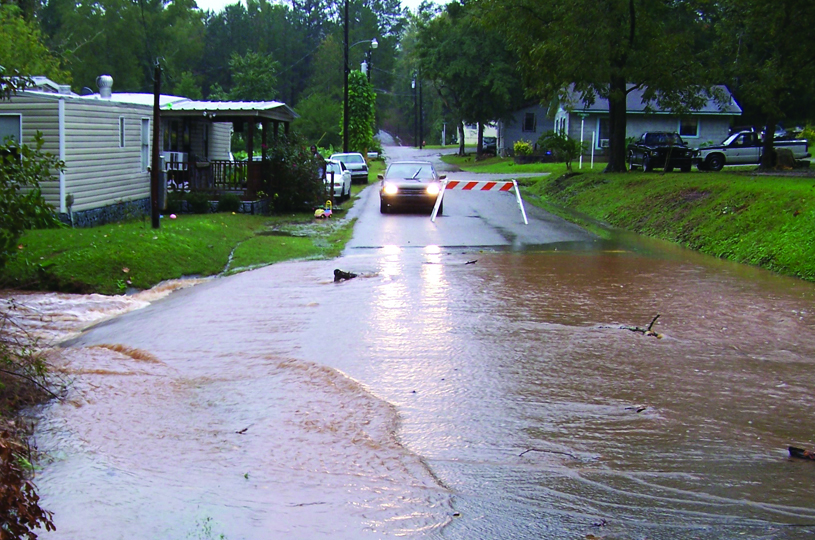|
NWS Flood Products: What Do They Mean?
Flash Flood Warning, Areal Flood Warning, River Flood Warning or Urban and Small Stream Flood Advisory
|
|
A variety of flooding and related phenomena place Central Alabama at risk throughout the year. Flooding can result from a number of weather systems including slow-moving or stationary frontal systems, inland moving tropical cyclones and intense summertime thunderstorms. These systems can produce flash flooding in low lying flood prone areas and along small creeks and streams, as well as river flooding along mainstreams.
Sometimes, it can be difficult to differentiate between our flood products and what they mean, so let's take a look at each of them in hopes of clearing up any misconceptions or misunderstandings.
|
 |
|

|
Flood or Flash Flood Watches
Much like our Severe Thunderstorm and Tornado Watches and Warnings, we issue Flash Flood Watches and Warnings. Flood Watches are issued to inform the public, cooperating agencies, and other interests that the current and/or developing weather pattern is such that there is a potential for rapid flooding (also known as flash flooding), more widespread areal flooding, or river flooding. The occurrence of flooding is neither certain nor imminent. Persons in the watch area are advised to check flood action plans, keep informed, and be ready to take necessary actions if a warning is issued or flooding is observed. A Flash Flood Watch may also be issued for a potential dam break.
|
|
Flood or Flash Flood Warnings
A Flood or Flash Flood Warning is issued to inform the public that flooding is imminent or in progress. It focuses on specific counties, communities, streams, or areas. Flash Flood Warnings are issued for flooding usually occurring within 6 hours of heavy rain. An Areal Flood Warning is issued for flooding that occurs more gradually, normally from prolonged and persistent moderate to heavy rainfall. A River Flood Warning is issued when a river is forecast to go above its designated flood stage at the forecast point.
|
 |
|

|
Areal Flooding vs Flash Flooding
These two types of flooding may be confusing, so we thought we would take a minute to try and clarify the difference between them.
A Flash Flood Warning is issued for flooding that normally occurs within six hours of heavy or intense rainfall. This results in small creeks and streams quickly rising out of their banks. Dangerous flooding in areas near these creeks and streams, as well as low-lying flood prone areas, develops very quickly and is a significant threat to life and/or property.
An Areal Flood Warning is normally issued for flooding that develops more gradually, usually from prolonged and persistent moderate to heavy rainfall. This results in a gradual ponding or buildup of water in low-lying, flood prone areas, as well as small creeks and streams. The flooding normally occurs more than six hours after the rainfall begins, and may cover a large area. However, even though this type of flooding develops more slowly than flash flooding, it can still be a threat to life and property.
Pictured is a typical example of areal flooding.
|
|
Flood Advisories
A Flood Advisory is issued when flooding that is not considered a significant threat to life or property is expected or occurring. This usually deals with nuisance flooding problems, such as flooding in low-lying areas and areas of poor drainage, as well as minor flooding of streets and roadways. This type of flooding causes some inconvenience, but is not generally considered a significant threat to life or property.
Flood Advisories are normally issued as an Urban and Small Stream Flood Advisory.
|

|
|

|
Other Important Information
Unlike our Severe Thunderstorms or Tornado Warnings, flood products are normally issued for extended periods of time. These warnings are normally issued for 2 to 4 hours, or longer. Even though rainfall may have subsided, flooding may persist for some time. The longer warning time allows for rainwaters to recede while keeping the public aware that flooding is still occurring and there is still a threat to life and/or property in the warned area.
Flood and Flash Flood Warnings will be transmitted on NOAA Weather Radio, and WILL alert your radio. Advisories do NOT alert your radio. You can also follow these products from the front page on our website, as well as from the Advanced Hydrologic Prediction Service (AHPS) web page.
It is important that the public is aware of this information, but equally as important is the reporting of any type of flooding. If you see any of the above, contact us!
NWS Birmingham Public Phone Line: 205-664-3010
Press 2 for a forecaster
Twitter: @NWSBirmingham or #ALWX
Facebook
|
|